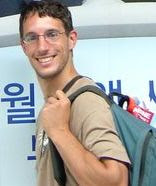We're back on the trains again, and happy with it. Bus travel in Vietnam is either in public buses, which are old and bumpy and where tourists get ripped off as a rule, or in tourist buses, shared, well, with tourists.
Not many travellers in Vietnam seem to use the train, but there's actually a convenient train line between Hanoi and Saigon, the so-called Reunification Express. Ok, they are quite slow, but taken that the line was almost completely destroyed during the Vietnam War, it's quite an achievement to be able to ride the train here.
As in China, there's no first-second-third class system (we're in a communist country, no classes, no difference between rich and poor, right?), but there are "hard seats" and "soft seats". The difference is pretty self-explanatory.
"Soft seat" is comfortable enough for a long trip, with reclining chairs and small tables, and you can buy a meal for 1 Euro and have it delivered to your seat. It consists of a big dollop of white rice in a plastic tray, along with a piece of chicken and a ladleful of what you might call soup.
In order not to get bored during the trip, there are 2 TV screens showing "Rail TV". They basically take programs from other chains and show a mix of travel shows, Vietnamese singers trying to sing like Patricia Kaas, Casper the friendly ghost dubbed in Vietnamese, and "hidden camera" shows. All this, of course, with the sound turned up to the maximum. People here must be either genetically different to be less sensitive to noise, or else they all become somewhat deaf by being constantly exposed to it. Only the stupid foreigners seem to mind the blaring loudspeakers.
The trains are usually quite full. People travel with everything, but especially cardboard boxes and plastic bags. At major stations, the getting off - getting on process is loud and a big confusion. People get off at one end of the carriage, while others get on at the other end, pushing and shoving and shouting, with their motorbike helmets still on. Although the seats are reserved, it seems to be important to get on first. Then everybody climbs onto the seats to find a place for their cardboard boxes and sports bags. At some point half of the people would get off again - they were only saying goodbye to those travelling. After the train pulls out of the station, there will usually be some shifting of seats with the help of the conductor, and some ticket checking which also seems to have its complications although I haven't yet quite understood everything.
The train goes at a mean speed of around 50 km/h, which leaves plenty of opportunities to watch the countryside. It was beautiful between Ninh Binh and Dong Hoi, with lots of rice fields and green hills. People with conical hats were working in the fields with their bare hands, ploughing them with buffaloes. As a tourist one would like to stop the train and take a lot of romantic pictures, but these people are just leading their everyday life that is not so romantic at all, it's just about having enough food and a roof over their heads.
The trip from Hue to Danang is supposed to be the most beautiful stretch of train travel in Vietnam, maybe that's why there were so many tourists on this train. Anyway, it was beautiful, with a lot of nice views of the sea.
We will now continue until Saigon, with a few stops in between. There we will have to take buses again to cross Cambodia...
Visualizar Next stop: where? em um mapa maior
Subscribe to:
Post Comments (Atom)

No comments:
Post a Comment